
Viverridae is a family of small to medium-sized, feliform mammals. The viverrids comprise 33 species placed in 14 genera. This family was named and first described by John Edward Gray in 1821. Viverrids occur all over Africa, southern Europe, and South and Southeast Asia, across the Wallace Line.

John Edward Gray was a British zoologist. He was the elder brother of zoologist George Robert Gray and son of the pharmacologist and botanist Samuel Frederick Gray (1766–1828). The standard author abbreviation J.E.Gray is used to indicate this person as the author when citing a botanical name. The same is used for a zoological name.

The saltwater crocodile is a crocodilian native to saltwater habitats, brackish wetlands and freshwater rivers from India's east coast across Southeast Asia and the Sundaic region to northern Australia and Micronesia. It has been listed as Least Concern on the IUCN Red List since 1996. It was hunted for its skin throughout its range up to the 1970s, and is threatened by illegal killing and habitat loss. It is regarded as dangerous to humans.

Campanula is the type genus of the Campanulaceae family of flowering plants. Campanula are commonly known as bellflowers and take both their common and scientific names from the bell-shaped flowers—campanula is Latin for "little bell".

The family Campanulaceae, of the order Asterales, contains nearly 2400 species in 84 genera of herbaceous plants, shrubs, and rarely small trees, often with milky sap. Among them are several familiar garden plants belonging to the genera Campanula (bellflower), Lobelia, and Platycodon (balloonflower). Campanula rapunculus and Codonopsis lanceolata are eaten as vegetables. Lobelia inflata, L. siphilitica and L. tupa and others have been used as medicinal plants. Campanula rapunculoides may be a troublesome weed, particularly in gardens, while Legousia spp. may occur in arable fields.

The Asian small-clawed otter, also known as the oriental small-clawed otter and the small-clawed otter, is an otter species native to South and Southeast Asia. It has short claws that do not extend beyond the pads of its webbed digits. With a total body length of 730 to 960 mm, and a maximum weight of 5 kg (11 lb), it is the smallest otter species in the world.

The mugger crocodile is a medium-sized broad-snouted crocodile, also known as mugger and marsh crocodile. It is native to freshwater habitats from southern Iran to the Indian subcontinent, where it inhabits marshes, lakes, rivers and artificial ponds. It rarely reaches a body length of 5 m and is a powerful swimmer, but also walks on land in search of suitable waterbodies during the hot season. Both young and adult mugger crocodiles dig burrows to which they retreat when the ambient temperature drops below 5 °C (41 °F) or exceeds 38 °C (100 °F). Females dig holes in the sand as nesting sites and lay up to 46 eggs during the dry season. The sex of hatchlings depends on temperature during incubation. Both parents protect the young for up to one year. They feed on insects, and adults prey on fish, reptiles, birds and mammals.

The Barbary lion, also called the North African lion, Atlas lion, and Egyptian lion, is an extinct population of the lion subspecies Panthera leo leo. It lived in the mountains and deserts of the Maghreb of North Africa from Morocco to Egypt. It was eradicated following the spread of firearms and bounties for shooting lions. A comprehensive review of hunting and sighting records revealed that small groups of lions may have survived in Algeria until the early 1960s, and in Morocco until the mid-1960s. Today, it is locally extinct in this region. Fossils of the Barbary lion dating to between 100,000 and 110,000 years were found in the cave of Bizmoune, near Essaouira.
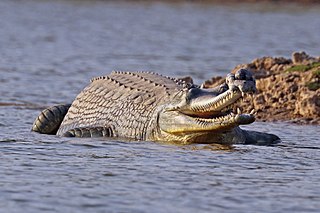
The gharial, also known as gavial or fish-eating crocodile, is a crocodilian in the family Gavialidae and among the longest of all living crocodilians. Mature females are 2.6 to 4.5 m long, and males 3 to 6 m. Adult males have a distinct boss at the end of the snout, which resembles an earthenware pot known as a ghara, hence the name "gharial". The gharial is well adapted to catching fish because of its long, narrow snout and 110 sharp, interlocking teeth.
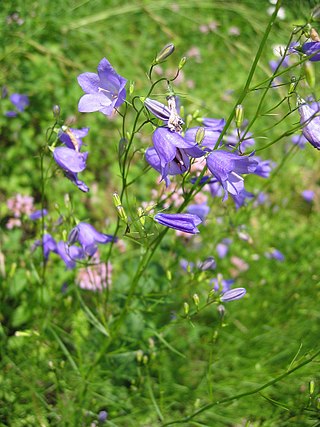
Campanula rotundifolia, the harebell, Scottish bluebell, or bluebell of Scotland, is a species of flowering plant in the bellflower family Campanulaceae. This herbaceous perennial is found throughout the temperate regions of the northern hemisphere. In Scotland, it is often known simply as bluebell. It is the floral emblem of Sweden where it is known as small bluebell. It produces its violet-blue, bell-shaped flowers in late summer and autumn.

A hydathode is a type of pore, commonly found in angiosperms, that secretes water through pores in the epidermis or leaf margin, typically at the tip of a marginal tooth or serration. Hydathodes occur in the leaves of submerged aquatic plants such as Ranunculus fluitans as well as herbaceous plants of drier habitats such as Campanula rotundifolia. They are connected to the plant vascular system by a vascular bundle. Hydathodes are commonly seen in water lettuce, water hyacinth, rose, balsam, and many other species.
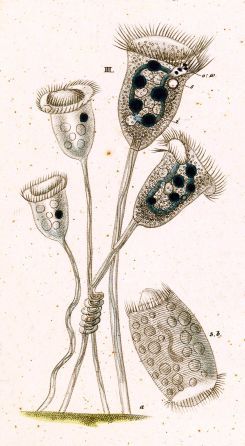
Vorticella is a genus of bell-shaped ciliates that have stalks to attach themselves to substrates. The stalks have contractile myonemes, allowing them to pull the cell body against substrates. The formation of the stalk happens after the free-swimming stage.
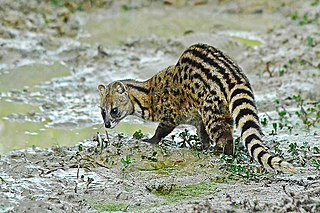
The small Indian civet is a civet native to South and Southeast Asia. It is listed as Least Concern on the IUCN Red List because of its widespread distribution, widespread habitat use and healthy populations living in agricultural and secondary landscapes of many range states.
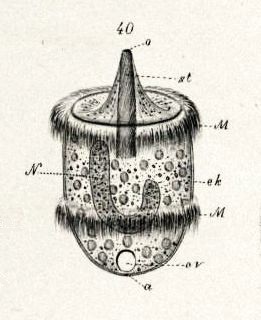
Didinium is a genus of unicellular ciliates with at least ten accepted species. All are free-living carnivores. Most are found in fresh and brackish water, but three marine species are known. Their diet consists largely of Paramecium, although they will also attack and consume other ciliates. Some species, such as D. gargantua, also feeds on non-ciliate protists, including dinoflagellates, cryptomonads, and green algae.

William John Broderip FRS was an English lawyer and naturalist.

The Arabian tahr is a species of tahr native to eastern Arabia. Until recently, it was placed in the genus Hemitragus, but genetic evidence supports its removal to a separate monotypic genus, Arabitragus.

Vorticella convallaria is a species of ciliates. It is the type species of the genus Vorticella. It resembles V. campanula, but differs in being somewhat narrow in the anterior end and usually having no refractile granules in the endoplasm.
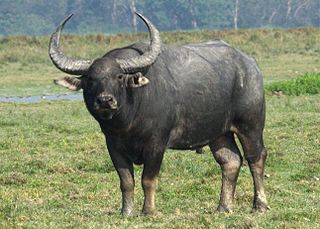
The wild water buffalo, also called Asian buffalo, Asiatic buffalo and wild buffalo, is a large bovine native to the Indian subcontinent and Southeast Asia. It has been listed as Endangered in the IUCN Red List since 1986, as the remaining population totals less than 4,000. A population decline of at least 50% over the last three generations is projected to continue. The global population has been estimated at 3,400 individuals, of which 3,100 (91%) live in India, mostly in Assam. The wild water buffalo is the most likely ancestor of the domestic water buffalo.

The Viverrinae represent the largest subfamily of the Viverridae comprising three genera, which are subdivided into six species native to Africa and Southeast Asia. This subfamily was denominated and first described by John Edward Gray in 1864.

Paradoxurinae is a subfamily of the feliform viverrids that was denominated and first described by John Edward Gray in 1864. Pocock subordinated the genera Paradoxurus, Paguma and Arctictis to this subfamily.


















